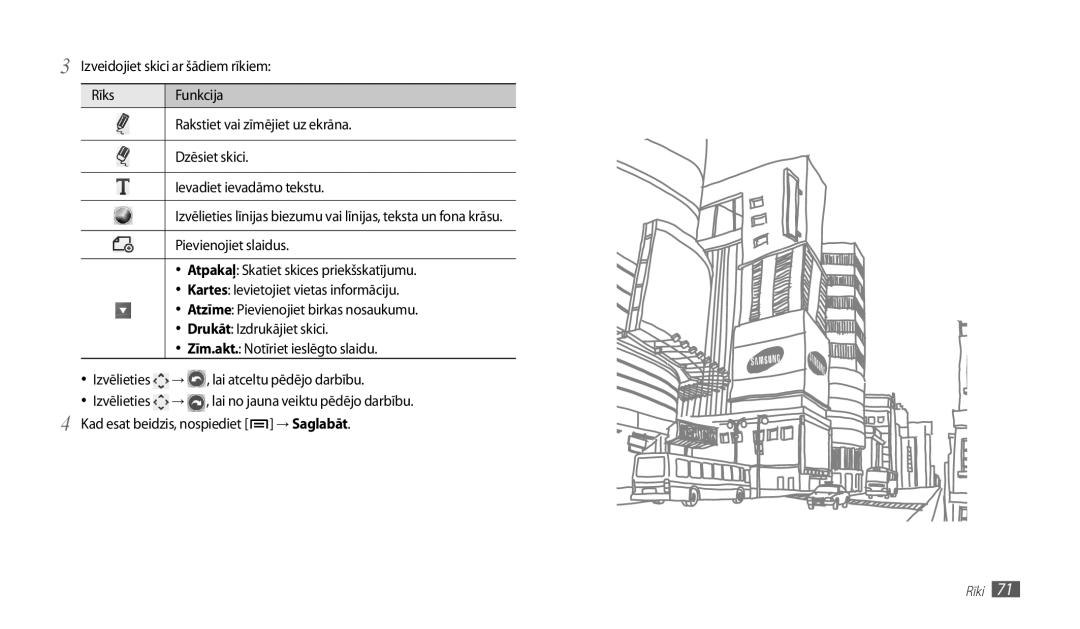Lietotāja rokasgrāmata
Izlasīt pirms ierīces izmantošanas
Šīs rokasgrāmatas lietošana
Preču zīmes
Bluetooth ir Bluetooth SIG, Inc. reģistrēta preču zīme
Instrukcijās izmantotās ikonas
Autortiesības
PAR Divx Video
Salikšana
Saturs
Personiskā informācija
Iestatījumi
Akumulatora uzlāde
Salikšana
Komplektācija
Ievietojiet SIM vai Usim karti
Ievietojiet SIM vai Usim karti
USB strāvas adapteri pieslēdziet pie strāvas kontaktligzdas
SIM vai Usim kartes ievietošana
Atmiņas kartes ievietošana papildiespēja
››Atmiņas kartes formatēšana
››Atmiņas kartes izņemšana
››Pārslēgties uz klusuma režīmu
Darba sākšana
Ierīces ieslēgšana un izslēgšana
››Pārslēgties uz lidojuma režīmu
››Ierīces izkārtojums
Iepazīšanās ar ierīci
››Indikatora ikonas
››Taustiņi
Notiek mūzikas atskaņošana
Aktivizēts klusuma režīms
Aktivizēts vibrēšanas režīms
Aktivizēts lidojuma režīms
››Skārienekrāna bloķēšana vai atbloķēšana
Skārienekrāna lietošana
››Skārienekrāna pagriešana
Attiecīgo paneli
Iepazīšanās ar sākumekrānu
››Vienumu pievienošana sākumekrānam
Cipars Funkcija
››Īsceļu paneļa izmantošana
Piekļuve lietojumprogrammām
››Vienumu pārvietošana uz sākumekrānu
››Displeja valodas maiņa
Ierīces pielāgošana
››Lietojumprogrammu kārtošana
››Uzdevumu pārvaldnieka izmantošana
››Iestatiet ekrāna bloķēšanu
››Animācijas aktivizēšana, pārslēdzot logus
››Displeja spilgtuma pielāgošana
››Mobilā meklētāja aktivizēšana
››SIM vai Usim kartes bloķēšana
››Teksta ievade ar Swype tastatūru
Teksta ievade
››Teksta ievades metodes maiņa
Ievadīt bieži izmantotos simbolus
››Teksta ievade ar Samsung tastatūru
Izdzēst rakstzīmes
››Teksta kopēšana un ielīmēšana
››Tīmekļa lapu pārlūkošana
Tīmeklis
Pārlūks
››Vairāku lapu atvēršana
››Informācijas meklēšana ar balsi
››RSS plūsmas adreses pievienošana
››Grāmatzīmju veidošana izlases tīmekļa lapām
››Lasīt ziņu rakstus
Readers Hub
Ziņas un laika prognoze
››Skatīt informāciju par laikapstākļiem
››Plūsmu avotu pārvaldība
Pulse
Samsung Apps
››Plūsmu lasīšana
››Videoklipu skatīšanās
Market
YouTube
››Lietojumprogrammas atinstalēšana
››Aplūkot ikdienas apskatu
Ikdienas apskats
››Pielāgojiet ikdienas apskata iestatījumus
››Noteiktas atrašanās vietas meklēšana
Kartes
Latitude
→ Sk. karti
Vietas
Navigācija
Google meklēšana
››E-pasta ziņas skatīšana
Sakari
Google Mail
››E-pasta ziņu sūtīšana
Izvēlieties Mainīt iezīmes
Pasts
››E-pasta konta iestatīšana
Izvēļņu režīmā izvēlieties Talk
Tērzēšana
››Draugu pievienošana draugu sarakstam
Izvēlieties Pievienot un pievienojiet failu
››Multiziņas sūtīšana
Ziņas
››Tērzēšanas sākšana
››Īsziņas sūtīšana
››Balss pasta ziņu noklausīšanās
Zvanīšana
››Īsziņas vai multiziņas skatīšana
››Izmantojiet balss zvana laikā pieejamās opcijas
››Zvanīšana un atbildēšana uz zvanu
››Papildfunkciju lietošana
››Opciju izmantošana video zvana laikā
››Neatbildēto zvanu apskatīšana un atzvanīšana
Pārsūtīšana
Automātiska noraidīšana
Izvēlieties Automātiskais noraidīto saraksts
Zvanu numuri → Aktivizēt fiksēto zvanu numurus
››Zvanu arhīvu apskatīšana
Social Hub
››Mūzikas atskaņošana
Izklaide
Mūzika
››Mūzikas failu pievienošana ierīcei
Nospiediet → Jauns atskaņojumu saraksts
Music Hub
››Atskaņošanas saraksta izveide
››Mūzikas atskaņotāja iestatījumu pielāgošana
››Fotografēšana
Kamera
››Panorāmas fotoattēla uzņemšana
››Fotoattēlu sērijas uzņemšana
Veiciet visus nepieciešamos pielāgojumus
››Fotoattēlu uzņemšana smaidoša foto režīmā
››Fotoattēlu uzņemšana pašportreta foto režīmā
››Pielāgot kameras iestatījumus
››Videoklipa ierakstīšana
››Videokameras iestatījumu pielāgošana
Izvēlieties mapi
Video
Galerija
››Fotoattēla skatīšana
Ikonu, kuru vēlaties atskaņot
››Videoklipa atskaņošana
Pusē
››Kontakta atrašana
Personiskā informācija
Kontakti
››Kontakta izveide
Nospiediet → Kopēt ierīcē vai Pārvietot uz ierīci
››Vizītkartes izveide
››Kontaktu grupas izveide
››Kopēt vai pārvietot kontaktus
››Notikuma izveide
Kalendārs
››Kontaktu importēšana vai eksportēšana
››Kalendāra skata maiņa
››Atgādinājuma izveide
Piezīme
››Notikumu apskate
››Notikuma signāla apturēšana
››Pievienošana izmantošanai par lielapjoma atmiņas ierīci
Savienojamība
Savienojumi ar datoru
››Savienojums ar Samsung Kies
Iestatījumi → Lielapjoma atmiņa
Wi-Fi
Wi-Fi iestatījumi
››WLAN funkcijas aktivizēšana
››WLAN atrašana un savienojuma izveide
Fi iestatījumi → Piev. Wi-Fi tīklu
Wi-Fi iestatījumi → WPS pogas savienojums
Mobilā tīkla koplietošana
››Koplietojiet ierīces mobilo tīklu, izmantojot USB
Bluetooth
››Datu saņemšana, izmantojot Bluetooth bezvadu funkciju
››Bezvadu Bluetooth funkcijas ieslēgšana
››Failu atskaņošana citā ierīcē ar Dlna funkciju
AllShare
››Aktivizēt atrašanās vietas pakalpojumus
Savienojumi ar TV TV izejas režīms
Iestatījumi → VPN pievienošana
VPN savienojumi
››VPN savienojumu iestatīšana
Iestatījumi
››Pievienojieties privātam tīklam
ThinkFree Office
Rīki
Grāmata
››Dokumentu pārvaldīšana tiešsaistē
Mani faili
››Jauna dokumenta izveide
››Kopēt vai izgriezt failus
››Atbalstītie failu formāti
››Atvērt failu
››Izveidot mapi
Modinātājs
Lejupielādes
Fotorāmis
››Modinātāja signāla dzēšana
Kalkulators
››Jauna modinātāja signāla iestatīšana
››Modinātāja signāla pārtraukšana
Rokraksta piezīmes
Uzdevumu pārvaldnieks
Pasaules pulkstenis
Meklēšana ar balsi
Rīki
Bezvadu funkcija un tīkls
Iestatījumi
Piekļuve iestatījumu izvēlnei
Zvana iestatījumi
Skaņa
Iestatīt SIM kartes bloķēšanu
Displejs
Atrašanās vieta un drošība
Fona attēli
Mainiet iestatījumus instalēto lietotņu pārvaldīšanai
Programmas
Meklēt
Konti un sinhronizācija
Konfidencialitāte
SD karte un ierīces krātuve
››Balss atpazīšanas iestatījumi
Balss ievade un izvade
››Swype
››Samsung tastatūra
››Teksta pārveide runā iestatījumi
Pieejamība
Datums un laiks
Par ierīci
Traucējummeklēšana
Pārbaudiet, vai netiek bloķēta ierīces iekšējā antena
Izejošie zvani nesavienojas
Pārliecinieties, ka ierīce atbalsta šo faila veidu
Atverot mūzikas failus, tiek parādīti kļūmes paziņojumi
Sargājiet ierīci, akumulatorus un lādētājus no bojājumiem
Drošības pasākumi
Neizmantojiet ierīci elektrokardiostimulatora tuvumā
Mobilās ierīces apkope un izmantošana
Esiet uzmanīgi, izmantojot ierīci pārvietojoties
Izstrādājuma pareiza likvidēšana
Šī izstrādājuma bateriju pareiza utilizācija
Alfabētiskais rādītājs
Importēšana vai eksportēšana
Sk. tīmekļa pārlūks
Neatbildēto zv. apskatīšana
Sinhronizācija
Atbilstības deklarācija R&TTE
Kies sinhr. ar datoru instalēšana

